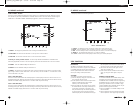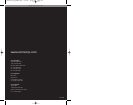
GETTING STARTED WITH SINGLE SIDEBAND
(SSB)
Many high-end shortwave radios have a feature called
SSB, a highly efficient way of electronically processing
transmitted and received signals for two-way commu-
nication. Examples of this are amateur radio (hams),
maritime and aeronautical communication. Either
upper side band (USB) or lower side band (LSB) can be
used.
Receiving SSB signals is not always easy. Since this is
two-way communications, transmissions are often very
short and sporadic.Also,most two-way communica-
tions uses relatively low power,50 to 1000 watts.The
amateur radio operators are easiest to find; the others
can be very difficult. Best results are experienced when
using an outdoor shortwave antenna such as a dipole.
Finding SSB signals can be like seeking a “needle in a
haystack”, so be patient! The easiest place to find SSB
communications is at night in the amateur band
shown below at 3650-4000 kHz. Follow your radio’s
instructions on how to engage its SSB feature. Below
are some selected frequency ranges on which SSB
communications can be found.All frequencies are
shown in kilohertz.
Aeronautical
(usually USB)
Amateur Radio
80m:
3650-4000,
LSB,night.
40m: 7150-7300, LSB, day/night.
20m: 14150-14350, USB, day.
15m: 21150-21450, USB, day.
10m: 28300-28600, USB, day.
2850-3155
3400-3500
4650-4750
5480-5730
6525-6765
8815-9040
10005-10100
11175-11400
13200-13360
Aeronautical
(usually USB)
15010-15100
17900-18030
21870-22000
23200-23350
Maritime (usually USB)
4063-4438
6200-6525
8195-8815
12230-13200
16360-17410
18780-18900
19680-19800
22000-22720
25070-25110
56 57
E
1
M
ANUAL
APPENDIX - UNDERSTANDING SHORTWAVE BANDS continued
APPENDIX - UNDERSTANDING SHORTWAVE BANDS continued
FULL-SIZED PASSIVE SHORTWAVE ANTENNAS
These normally give the best performance.Generically
they have names such as dipoles, trapped dipoles, par-
allel dipoles and slopers.They are characteristically fed
with 50 or 75 ohm coaxial cable that leads to the
radio’s antenna socket. Even if you build one of these
using instructions from a book, these antennas are an
‘engineered system’, thus optimizing performance.
ACTIVE SHORTWAVE ANTENNAS (usually small)
Active antennas are much smaller than others and
employ the use of amplifiers to compensate for their
small size.There are many models to choose from.They
usually do not perform as well as passive or non-
amplified, professionally engineered models but are
useful when a short, small size is needed.
SHORTWAVE ANTENNAS FOR USE ON BOATS
RF Systems makes the model MARINE BALUN KIT
(about $90 USD), which can turn a backstay or a long
piece of wire into an efficient shortwave receiving
antenna. McKay Dymek makes the model DA-100EM
(about $200 USD), mountable on a mast or railing, the
antenna being only about 1.5 meter high (4 ft. 8 in.).
LONG-WIRE SHORTWAVE ANTENNAS
If your radio does not have an antenna socket, or if
you want to take a simpler or less costly approach, this
type of antenna can improve signal levels. Understand,
however, that this not an engineered system and noise
levels may still be quite high. Such antennas are
attached directly to the radio’s telescopic antenna with
an ‘alligator’ clip or other secure attachment device.
AM ANTENNAS
We are often asked about AM antennas.Such anten-
nas, usually AM-Loop antennas, are made by a variety
of manufacturers and often work extremely well to
boost signals. One brand, Select-A-Tenna, is a time-
proven performer and includes models ranging from
about $60-$200.
FINDING ANTENNAS
One way to find antennas is by performing a search on
the Internet.
TIME STATIONS
CHU-time (Canada)
CHU-time(Canada)
CHU-time (Canada)
WWV
-time/weather(US)
WWV
-time/weather(US)
WWV-time/weather(US)
WWV
-time/weather(US)
WWV-time/weather(US)
3,330 kHz
7,335 kHz
14,670 kHz
2,500 KHZ
5,000 KHz
10,000 kHz
15,000 kHz
20,000 kHz
Best at night
Day/night
Best during daylight
Best at night
Best at night
Day/night
Best during daylight
Best during daylight
TIME ST
ATIONS not SSB
CHU-time (Canada)
CHU-time(Canada)
CHU-time (Canada)
WWV-time/weather(US)
WWV-time/weather(US)
WWV-time/weather(US)
WWV
-time/weather(US)
WWV-time/weather(US)
3,330 kHz
7,335 kHz
14,670 kHz
2,500 KHZ
5,000 KHz
10,000 kHz
15,000 kHz
20,000 kHz
Best at night
Day/night
Best during daylight
Best at night
Best at night
Day/night
Best during daylight
Best during daylight
E1_manual_eng_APR06.qrk 5/5/06 10:22 AM Page 58


















